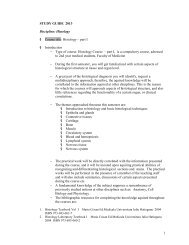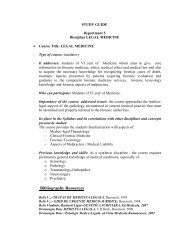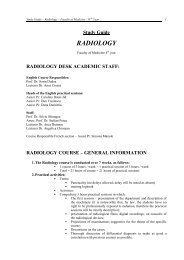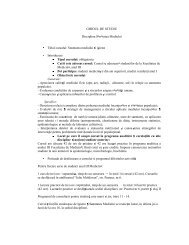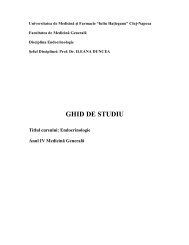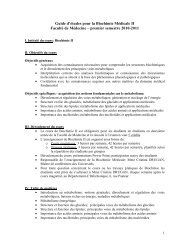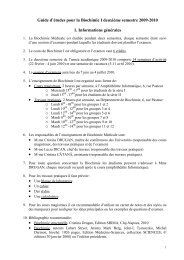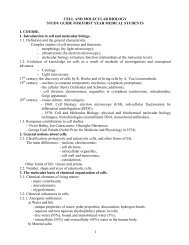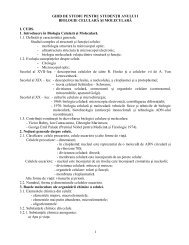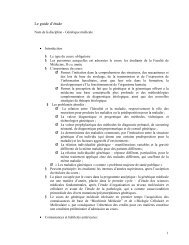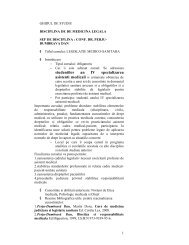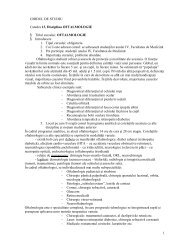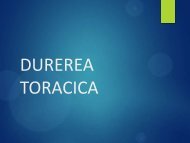Medical Research Methodology - UMF - Iuliu Haţieganu
Medical Research Methodology - UMF - Iuliu Haţieganu
Medical Research Methodology - UMF - Iuliu Haţieganu
You also want an ePaper? Increase the reach of your titles
YUMPU automatically turns print PDFs into web optimized ePapers that Google loves.
<strong>Medical</strong> <strong>Research</strong> <strong>Methodology</strong><br />
TABLE OF CONTENTS<br />
TABLE OF CONTENTS...........................................................................................................................1<br />
INTRODUCTION ..................................................................................................................................2<br />
NECESSARY PREVIOUS KNOWLEDGE ...................................................................................................3<br />
ACADEMIC REGULATIONS...................................................................................................................4<br />
DEPARTMENT REGULATIONS AND WORKPLACE SAFETY RULES ...........................................................5<br />
TEACHING STAFF AND CONSULTATIONS .............................................................................................6<br />
BIBLIOGRAPHIC RESOURCES................................................................................................................6<br />
STRUCTURE OF THE LECTURE AND OF THE PRACTICAL ACTIVITIES.......................................................7<br />
OBJECTIVES OF THE LECTURE AND OF THE PRACTICAL ACTIVITIES.......................................................8<br />
TEACHING METHODS ..........................................................................................................................8<br />
EVALUATION METHODS......................................................................................................................8<br />
1
INTRODUCTION<br />
Development of digital computers has brought important changes in medical<br />
research as in many other areas. Calculations can be performed quickly, easily and<br />
accurately, with a wide range of instruments: from pocket calculators with incorporated<br />
statistical functions to powerful computers capable of analyzing considerable amounts of<br />
data. But the important thing to know is WHY certain calculations are made and which the<br />
SIGNIFICANCE of the obtained results is. Hence, the danger that appears does not derive<br />
from computers performing inexact calculations but from applying statistical methods<br />
without following a particular purpose, or without understanding the significance of the<br />
findings. Often a medical practitioner or researcher wonders about the significance of a<br />
folder of printed pages. Most of the times, the answer is that another tree has died in vane.<br />
Computers are a real support for laborious statistical analysis involving calculations<br />
that would have taken days some decades ago and today they can be solved in seconds. But<br />
the wide availability of computers, proved by the vast number of publications that include<br />
sophisticated processing, frequently gave way to the use of inappropriate statistical<br />
methods. This happens when users look at data analysis as a purely technical problem of<br />
calculation and not as a methodological problem, thus asking computer experts for advice<br />
rather than a research methodologist. They regularly receive helpful tips on how to proceed<br />
but erroneous indications about how to collect and analyze data and how to interpret the<br />
results. It is therefore extremely important that physicians, producers and consumers of<br />
medical research, understand the use and limits of statistical techniques.<br />
Clinical research, involves both the producer of science (designer and executor of the<br />
study) and the consumer scientist (practitioner willing to apply the results of a<br />
study). Communication between groups, sending and receiving messages between people of<br />
different culture and education can be achieved only by accepting and applying universal<br />
agreements, a common language of research.<br />
Clinical scientific research methodology, without restrictions or scholasticism, offers<br />
the possibility of communication between all those who devote their activity to cutting edge<br />
medical practice.<br />
2
<strong>Medical</strong> Informatics and Biostatistics courses provide the foundations for understanding<br />
<strong>Medical</strong> <strong>Research</strong> <strong>Methodology</strong>.<br />
NECESSARY PREVIOUS KNOWLEDGE<br />
Using the computer, basic level (working with files, text editing, Internet: WWW, email).<br />
For the study of research methodology it is necessary to understand the material taught in courses of<br />
<strong>Medical</strong> Informatics and Biostatistics.<br />
3
ACADEMIC REGULATIONS<br />
1. To complete the number of credits allotted to a subject matter, undergraduates must attend 70%<br />
of the courses of the respective subject matter.<br />
2. Attendance to practical activities is 100% compulsory. No changes of schedule will be accepted<br />
for practical activities.<br />
3. All absences MUST be compensated.<br />
4. A student is only allowed to compensate for up to 20% of the teaching activities.<br />
5. Justified absences may be compensated for only AFTER a medical justification has been issued<br />
by the Dean’s Office. The original justification must be presented no later than 10-working days<br />
following the student’s resuming coursework along with a copy that will be kept as a record by<br />
the assisting professor. Justifying documents which were not registered with the Dean’s Office<br />
and with the Department within the above-mentioned period will not be taken into account.<br />
6. Unjustified absences may be compensated for only AFTER a proof of payment has been issued<br />
by the pay office of the University, based on the order of payment stating the number of missed<br />
activity hours.<br />
7. Absences can be compensated only AFTER proper justification or payment and only with the<br />
assisting professor of the respective group. Compensations of absences with other members of<br />
the teaching staff are not acceptable.<br />
8. Students will not be allowed to sit an exam until ALL missed practical classes have been<br />
compensated for. Only students who have compensated for ALL absences before the beginning<br />
of the examination session may participate in the examinations. Missed practical classes may<br />
NOT be compensated during examination sessions.<br />
9. Students who have not compensated for ALL absences before the beginning of the examination<br />
session will arrange, together with the assisting professor of their group, another time-span in<br />
order to compensate for their absences (during the following semester / module, if that is still<br />
possible during the same academic year, or during the following years, if that is not the case).<br />
10. Practical / theoretical examinations are recognized during the same academic year. Students<br />
who passed only one of the two examinations are not required to repeat the exam they have<br />
passed, during the same academic year.<br />
11. Students who are enrolled by transfer and need to pass supplementary examinations to<br />
compensate for differences in the syllabi will schedule these examinations together with the<br />
professor in charge of that course, before the beginning of the examination session, based on the<br />
proof of payment issued by the Dean’s Office.<br />
12. Students who need to pass examinations to compensate for transferred credits will schedule<br />
these examinations together with the professor in charge of that course, before the beginning of<br />
the examination session, based on the proof of payment issued by the Dean’s Office. Prior to<br />
that, unless ALL academic responsibilities have been met in previous years (attendance of<br />
courses and practical classes), a compensation schedule for missed classes must be agreed upon<br />
and completed together with the former assisting professor of the group, based on proof of<br />
compensation payment issued by the Dean’s Office.<br />
4
DEPARTMENT REGULATIONS AND WORKPLACE SAFETY RULES<br />
1. Students may only use software installed by the network administrator. Installing and working<br />
with external software is strictly prohibited.<br />
2. Students may use the computers only for learning purposes, involving materials published on<br />
the Department web site.<br />
3. Students are not allowed to plug-in or plug-out any electronic equipment. Students may not<br />
power-on or power-off the computers; this operation may only be performed by teaching or<br />
technical staff of the Department.<br />
4. For their own protection, students must announce any equipment malfunction to the<br />
Department technician, in order to institute proper maintenance measures.<br />
5. Every student must scan his/her personal access card using the electronic presence-registration<br />
system at the ground-floor entrance, each time they enter or exit an activity at our Department<br />
(course or practical activity).<br />
6. Transmitting the personal access card or communicating the personal password to other users is<br />
strictly prohibited.<br />
7. Please keep the Department building tidy. For hygiene and safety reasons, eating or drinking in<br />
the classrooms is not allowed. Any food or beverage must be kept inside a piece of luggage, in<br />
properly sealed containers, only to be used outside the classrooms.<br />
8. Smoking is strictly prohibited, both inside the Department building and within 25 feet (8 meters)<br />
of its doorways.<br />
9. Facilities inside the Department (equipments, restrooms, furniture, etc.) should be used in a<br />
careful and civilized manner. Repair costs for any damage resulting from abuse of Department<br />
facilities or other University property will be covered at the sole expense of the individual(s) who<br />
produced the damage. In severe cases, future access to Department facilities may be denied to<br />
individuals inflicting facility damage.<br />
10. Students may enter the Department no more than 10 minutes in advance of their scheduled<br />
activity (course or practical activity). Students who are more than 10 minutes late for their<br />
scheduled activity will be marked absent for the whole duration of that activity. Students who<br />
leave their classroom before the scheduled end of an activity, without an express approval from<br />
their professor, will receive an unjustified absence for the whole duration of that activity.<br />
11. Assistant professors and teaching assistants are entitled to expel from practical activities those<br />
students who are distracted from learning by other activities than those published on the<br />
Department web site. In such cases, the student will receive an unjustifiable absence for that<br />
entire practical activity.<br />
12. Any violation of the above regulations and safety rules may be sanctioned by withdrawing the<br />
student’s right to access the Department, for a progressive time-span between 2 weeks and 1<br />
semester, according to the severity of the violation. For all activities taking place during the<br />
respective time-span, the student will receive unjustifiable absences.<br />
5
TEACHING STAFF<br />
Lect. Dr. Horațiu Colosi<br />
Lect. Dr. Daniel Leucuța<br />
Assist. Dr. Dan Istrate<br />
Assist. Drd. Andrada Urda<br />
BIBLIOGRAPHIC RESOURCES<br />
Laboratories are open between 8.00-18.00 hours. Unless a laboratory is occupied, students are<br />
granted access to computers for teaching purposes only. The use of computers for personal or<br />
entertainment purposes is not allowed.<br />
Due to the highly dynamic concepts taught and assessed, courses are not fully covered by<br />
bibliographic resources; therefore we encourage students to actively assist in the lectures.<br />
Recommended bibliography:<br />
1. Lecture presentations: http://www.info.umfcluj.ro/<br />
2. Themes for practical activities: http://www.info.umfcluj.ro/<br />
3. Achimaş A. Metodologia Cercetării Ştiinţifice <strong>Medical</strong>e. Cluj-Napoca: Editura Universitară <strong>Iuliu</strong><br />
Haţieganu; 1999.<br />
4. Bolboacă S, Colosi H, Drugan T, Achimaş A, Ţigan S. Elements of <strong>Medical</strong> Informatics and<br />
Biostatistics. Cluj-Napoca: Ed. SRIMA, 2003.<br />
5. Machin D, Campbell MJ. Design of studies for medical research. Chichester, West Sussex: John<br />
Wiley & Sons Ltd; 2005.<br />
Scientific Circle<br />
The Department of <strong>Medical</strong> Informatics provides access to its laboratories and facilities to conduct<br />
research activities by students. When possible, we methodologically assist students in developing<br />
their license thesis.<br />
6
STRUCTURE OF THE LECTURE AND OF THE PRACTICAL ACTIVITIES<br />
LECTURES<br />
No. Topics<br />
1 Introduction<br />
2 <strong>Medical</strong> research strategy. <strong>Research</strong> phases<br />
3 Variables. Collection of data. Bibliographic documentation<br />
4 Bias and confounders. Description of a new health phenomenon<br />
5 Evaluation of a risk or prognostic factor<br />
6 Survival analysis<br />
7 Evaluation of a diagnostic test<br />
8 Clinical trials for the evaluation of a therapeutic approach<br />
9 Choosing statistical methods. Metanalysis<br />
10 Evidence based medicine (EBM)<br />
11 Estimators. Hypotheses testing<br />
12 Data presentation<br />
13 <strong>Medical</strong> writing<br />
14 <strong>Research</strong> ethics<br />
PRACTICAL ACTIVITIES<br />
No. Topics<br />
1 Safety rules. The Vancouver referencing system<br />
2 Bibliographic documentation<br />
3 Data collection and presentation<br />
4 Evaluation of a prognostic factor. Case-control<br />
5 Evaluation of a prognostic factor. Exposed-nonexposed<br />
6 Evaluation of a diagnostic test . Phases II and III<br />
7 Evaluation of a therapeutic approach. Randomized clinical trial<br />
8 Survival analysis<br />
9 <strong>Medical</strong> writing (oral communication of results – PowerPoint)<br />
10 <strong>Medical</strong> writing (written communication of results – critical appraisal of a scientific paper)<br />
11 Interpreting results of medical studies<br />
12 Validity evaluation of medical studies and EBM<br />
13 Recapitulative problems<br />
14 Practical examination<br />
7
OBJECTIVES OF THE LECTURE AND OF THE PRACTICAL ACTIVITIES<br />
The lecture offers to 2 nd year students of the Faculty of Medicine the fundamental knowledge<br />
regarding:<br />
1. Searching, recording and analyzing medical literature<br />
2. Domains of medical research and types of clinical studies<br />
3. Methods of medical research<br />
4. Analysis and interpretation of results from medical studies<br />
5. Principles of correct written and oral presentation of research results<br />
6. Principles of Evidence based Medicine (EBM)<br />
7. Ethical principles in medical research<br />
The practical labs have as an objective the acquisition and practice of knowledge regarding:<br />
1. Accessing relevant medical information through literature search<br />
2. Formulating correct research questions, choosing a research aim and objectives. Selecting<br />
and formulating research hypotheses. Identifying target populations. Understanding<br />
sampling methods. Defining appropriate research variables. Writing a research protocol.<br />
3. Understanding and choosing correct data collection methods<br />
4. Understanding and choosing correct data analysis methods<br />
5. Using specific computer tools to assist medical research<br />
6. Understanding and using correct principles for medical writing and oral presentations of<br />
medical research<br />
TEACHING METHODS<br />
Master lectures, interactive lectures, PowerPoint presentations<br />
Examples, exercises, case studies and research scenarios, assisted by computers<br />
EVALUATION METHODS<br />
<br />
<br />
Practical examination – Applicative problems based on research scenarios, followed by an<br />
interview. The ability to understand, to reason and to interpret research protocols and results, as<br />
well as practical abilities to use computers for medical research will be evaluated (30% of the<br />
final mark).<br />
Written examination – Multiple-choice questions aiming to evaluate the theoretical<br />
understanding and reasoning regarding the design of medical research, medical writing and<br />
interpreting results of scientific medical papers (70% of the final mark).<br />
Correction algorithm of the written examination:<br />
Question with 1 correct answer:<br />
- 5 concordances = 1 point<br />
- less than 5 concordances = 0 points<br />
Question with 2 correct answers:<br />
- 5 concordances = 1 point<br />
- 4 concordances = 0.5 points<br />
- less than 4 concordances = 0 points<br />
Question with 3 or more correct answers:<br />
- 5 concordances = 1 point<br />
- 4 concordances = 0.5 points<br />
- 3 concordances = 0.25 points<br />
- less than 3 concordances = 0 points<br />
8



